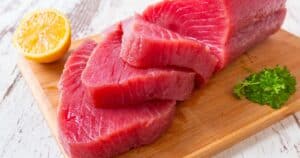Hey foodies! If you’re a sushi lover like me, you may have wondered, is sushi rice really short grain? Well, let me clear up the confusion.
Yes, traditional sushi rice is made from short-grain Japanese white rice. This type of rice has a higher ratio of amylopectin to amylose, giving it a wonderfully soft and sticky texture when cooked. Here are some key facts:
- Short-grain rice grains are almost round in shape, less than 6mm long. This allows the grains to cling together easily when cooked.
- The increased stickiness helps the rice hold its shape when formed into sushi rolls or nigiri sushi.
- Japanese varieties like Koshihikari and Akitakomachi are considered ideal for sushi because of their plumpness and ability to absorb seasoning.
- Despite the stickiness, short-grain rice remains tender with a subtle sweet flavor.
Now that you know sushi rice basics, dive deeper as I share tips on shopping for and cooking the perfect short-grain rice for sushi night!
What Makes a Rice Short Grain?
Rice is categorized by the length-to-width ratio of each grain. Long grain rice has grains that are at least four times as long as they are wide. Medium grain rice has grains two to three times as long as wide.
Short grain rice, sometimes called pearl rice, has grains that are less than twice as long as they are wide – giving the grains a nearly round, plump shape.
Japanese short grain varieties used for sushi have grains that are just 0.2–0.3 inches (5-6mm) in length. This round, stubby shape allows the grains to cling together when cooked.
Why Short Grain for Sushi?
Using short grain Japanese rice varieties is crucial for good sushi for two main reasons:
1. Texture
Short grain rice has a higher percentage of amylopectin starch than long grain varieties. Amylopectin is what gives the rice its desirable sticky, chewy texture when cooked.
The increased amylopectin content makes the rice:
- Soft and tender, even as it cools to room temperature
- Cohesive and sticky, allowing it to be picked up easily with chopsticks
- Able to be compressed tightly in sushi rolls and nigiri without falling apart
2. Flavor
In addition to texture, short grain Japanese rices like Koshihikari and Akitakomachi provide sweet, subtle flavor that complements sushi without overpowering the fish and fillings. Their ability to absorb seasoning maximizes the flavor.
Long grain jasmine or basmati rice would be far too dry and firm for the proper mouthfeel in sushi. Their aromatic flavors would also clash with the delicate sushi ingredients.
For authentic texture and taste, short grain is a must for sushi success!
The Science Behind Short Grain Stickiness
You may be wondering how short grain rice gets its distinct sticky texture compared to long grain. The secret lies in the ratio of two starch molecules – amylose and amylopectin.
Amylose vs Amylopectin
All rice contains amylose and amylopectin starches in different proportions:
- Amylose is a straight chain molecule that allows rice grains to remain separate and fluffy.
- Amylopectin has a highly branched structure, causing it to gelatinize and get sticky during cooking.
Long grain rices have a high amylose, low amylopectin ratio. This keeps the grains dry and separated.
Short grain rice has a low amylose, high amylopectin ratio – up to 20% more amylopectin for some Japanese varieties. It’s this abundance of amylopectin that makes short grain sushi rice deliciously gummy and clingy.
Shopping for Sushi Rice
Now that you know why short grain rice is crucial for sushi, let’s talk about how to shop for the right product:
Look for Japanese Varieties
Authentic sushi rice will always be labeled with a specific Japanese short grain rice name, like Koshihikari, Akitakomachi, Hitomebore, etc. These are specially cultivated strains considered ideal for sushi.
Avoid packages only marked “short grain” or “sushi rice”, as these could contain cheaper imitation rice.
Buy it White
True sushi rice will always be white. Some stores sell brown rice marketed as “sushi rice” – don’t be fooled! Brown rice lacks the proper sticky texture when cooked.
Seek Out Specialty Stores
Large grocery stores may not have a great sushi rice selection. Check international and Asian food markets for premium Japanese rice brands.
Online stores like Amazon also carry a huge variety of authentic short grain Japanese rices perfect for sushi.
Cooking Perfect Sticky Sushi Rice
Once you’ve got the right short grain Japanese rice, proper cooking technique is key to bringing out that irresistible sticky texture:
Rinse First
Before cooking, place the rice in a bowl and rinse with cold water while gently massaging the grains. This removes excess starch for a tender result.
Use a Rice Cooker
Although stovetop methods exist, a rice cooker offers foolproof rice every time. The precise temperature control prevents over or undercooking.
Add Vinegar While Hot
As soon as the rice is done, mix in vinegar, sugar, and salt while still piping hot. This allows maximum absorption into the grains.
Avoid Overmixing
Handle the cooked rice gently and avoid mushiness. Use a slicing motion to mix in vinegar rather than stirring aggressively.
Allow to Cool
Let the seasoned rice cool to room temperature before using for sushi. This firms it up while keeping the precious stickiness intact.
Now you can impress your sushi night guests with expertly made, authentic short grain rice!
Frequently Asked Questions
Can you use long grain rice for sushi?
No, long grain rice won’t give you the proper tender and sticky texture needed for sushi. The grains will be too dry and separate. Always opt for real Japanese short grain rice.
Is sticky rice the same as sushi rice?
Not quite! Sticky rice is a broad term that could apply to any glutinous Asian rice. True sushi rice must be a Japanese short grain variety specially cultivated for sushi purposes.
Is sushi rice gluten free?
Yes! Rice is naturally gluten free, and pure sushi rice contains no ingredients with gluten. However, check labeling if purchasing pre-seasoned products.
Can you make Brown sushi rice?
No – brown rice retains too much of the bran layer to properly gelatinize and get sticky enough for sushi. You’ll need to use traditional white Japanese short grain rice.
Now Enjoy Your Sushi Night!
There you have it – all the details on sushi’s secret short grain rice! I hope this gave you confidence to find and prepare authentic rice to take your sushi rolls to new heights.
Let me know in the comments if you have any other sushi rice questions. And share photos when you make your own incredible sushi creations at home with the perfect short grain rice!





